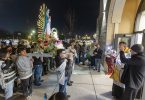
At 91, Siebert is still the picture of health. He continues to live in the farmhouse his father built and raises cattle. Here, he holds with his Army uniform from World War II.
Seventy years ago, Nazi Germany surrendered to allied forces and victory in Europe was declared. In honor of the many men and women across the archdiocese who — both on and off the battlefield — paid dearly for the freedom we enjoy today, we tell this story of one.
by Todd Habiger
todd.habiger@theleaven.org
It was not turning out to be a Merry Christmas for Julian Siebert.
It was 1944 in France. The Battle of the Bulge, which would claim more than 19,000 American lives, was raging. Siebert, a U.S. Army private, had been shot at, survived a nearby grenade explosion and now a German tank was barreling toward the building he had holed up in, ready to finish the job.
Seeing no way out, Siebert and the rest of the American soldiers in the building surrendered. Bad decision. The Germans marched their prisoners behind the building, lined them up and took aim.
Old memories
Sitting in the kitchen of the house he was born and raised in, Siebert, a member of St. Joseph Parish in Flush, doesn’t look like he’s old enough to have fought in the Battle of the Bulge. At 91, he looks and acts at least 20 years younger. He walks gracefully, without assistance, has a strong voice and a sharp mind. Despite his age, he still dabbles in farming, raising cattle.
He’s takes pride in his home, built by his father in 1904, a picturesque farmhouse tucked off the beaten path a few miles from the nearest town. Together, he and his wife Barbara raised five children in this house. It’s a life he never thought he would see as he was staring down the barrel of a rifle on that 1944 Christmas morning.
Siebert has no idea why he’s still alive, while so many others he fought beside aren’t.
“I said many a time that I thought I had a guardian angel on both shoulders and they were working overtime,” he said.
For 50 years, Siebert wouldn’t talk about the war. It was too painful. It was something he wanted to forget. But he couldn’t.
“For 30 years, I’d have nightmares,” he said. “I don’t know what I was dreaming of, but I would wake up so terribly scared.”
And during those 30 years the nightmares became progressively worse.
“Then, all of the sudden, they just quit. Just like you shut the switch off. I never had another one,” Siebert said.
Still, Siebert couldn’t talk about it — not to his wife. Not to his family.
After 50 years had passed, his daughter, who was a schoolteacher, asked if Siebert would like to talk to her class about the war. He declined. She waited a few years and asked again. This time he was ready.
Going to war
Siebert was drafted into the Army on May 4, 1944. He went to Fort Hood, Texas, for 17 weeks of basic training before he was shipped off to Europe and assigned to the 26th Infantry Division as a replacement.
He was immediately sent to the front lines. In the middle of December, his division was relieved and went to Metz, France, for some R&R. It didn’t last. The Germans launched their last gasp effort to turn the war around on Dec. 16.
“When the Battle of the Bulge started, they sent us right back out,” Siebert said. “They told us to find the enemy and engage them.”
The fighting was fierce. That Christmas morning, his platoon was pinned down in a French town before taking refuge in a stone building.
“[The Germans] got a grenade in there finally, and we tried to find it in the dark but we couldn’t find it,” he said. “We knew when it was going to go off, so we hit the corners of the room and it went off. My ears still ring, but no one got hurt.”
Then came the tank with its 88 mm gun — and surrender.
“They took us back to this pile of dirt and had us stand behind that,” he recalled. “The guy next to me said, ‘Looks like this is it.’
“I said, ‘It sure looks like it.’
“They were just about to pull the trigger when a vehicle pulled up behind them and a German officer got out.”
The officer stopped the execution and instructed his men to take the Americans prisoner instead.
Siebert was now a prisoner of war.
“We walked for days and days with very little to eat,” Siebert said. “Every once in a while, we got a little bit of buggy soup. As we were walking, we kept picking up more prisoners.”
The POWs finally arrived at a railroad yard where they were packed tight into a boxcar — standing room only for days . . . and no food.
The POWs eventually ended up at Stalag 12a in Germany.
“When we got there, one of guys that had been there awhile said, ‘When you’re first here and see a worm in your soup, you’ll probably dump it out. The next day, you will probably pick out the worm and eat the soup. After that, if you see one in your soup and he tries to crawl out, you’ll knock him back in,’” said Siebert.
“That’s the truth. You didn’t want to let anything get away that you could eat,” he added.
Siebert said that, every once in a while, they would get some bread that was probably 20 percent sawdust. Another time, a stray dog wandered into the camp and was shot by the guards.
“We ate that dog,” Siebert said. “It gave us a little bit of meat to eat. We were needing some protein.”
Eventually, it became apparent to the Germans that they were going to lose the war.
With the Soviets closing in from one direction and the Americans from the other, the German guards had the prisoners pack their belongings and start walking toward the American lines.
“That night, just before dark, we approached the American lines,” said Siebert. “The guards handed us their guns and said, ‘We’re your prisoners now.’”
The Germans preferred to surrender to the Americans rather than the Soviets, explained Siebert, for fear the Soviets would execute them immediately.
And just like that, the roles were reversed. The former prisoners marched their former captors to the American lines to safety and freedom. It was May 2, 1945.
“I was just real happy to be there and see Americans and see the American flag,” Siebert said. “You can’t believe how beautiful the American flag is after something like that.”
Six days later, the war in Europe was over. Siebert was ready to go home.
After the war
After returning home, Siebert got into farming. He rented land from a nearby farmer and farmed that land until 1966. Along the way, he got married and had five children.
“Farming was getting poor,” he said. “I thought I would never be able to send five kids to college on what I was making farming.”
Luckily for him, a position opened up in nearby Westmoreland for a mail carrier. Siebert applied and got the job. He remained a mail carrier for 22 years, retiring in 1988.
He also returned to his home parish, St. Joseph in Flush, where he has remained active for all his years.
Father Michael Peterson, pastor of St. Joseph, describes Siebert as a faith-filled man who would do anything for his church.
“He’s in great shape, both physically and spiritually,” Father Peterson said.
The war still remains a part of Siebert. After not talking about it for many years, he now talks about it quite a bit — to schools, veterans’ groups and reunions
While he’s proud of what he and the other soldiers that fought in the war accomplished, he scoffs at the notion that his is “The Greatest Generation,” as coined by Tom Brokaw.
“As far as being any greater than anyone else,” he said, “I don’t really feel that way.
“We just had a job that needed to be done and we went and did it.”






